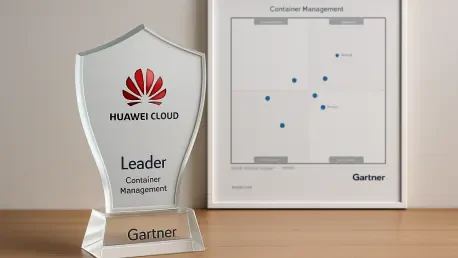Setting the Stage: A New Era in Cloud Computing
In an era where digital transformation dictates the pace of business innovation, container management has become the backbone of scalable, efficient IT infrastructure. With enterprises worldwide handling billions of containerized workloads annually, the cloud computing market is witnessing fierce competition among providers vying for dominance. Huawei Cloud has recently emerged as a standout contender, securing a position in the Leaders quadrant of the Gartner Magic Quadrant for Container Management. This achievement underscores a pivotal shift in the industry, raising questions about how a company facing geopolitical scrutiny can redefine market standards. This analysis delves into the trends propelling Huawei Cloud’s ascent, examines key data points behind its success, and offers projections on its potential to reshape the container management landscape.
Unpacking Market Dynamics: Huawei Cloud’s Strategic Position
Technological Innovation as a Market Driver
Huawei Cloud’s rise in the container management sector is fueled by its robust technological offerings, which have set a new benchmark for the industry. The company’s comprehensive product matrix—spanning public, hybrid, distributed clouds, and edge environments—has been recognized by Gartner as the most complete in the market. Tools such as CCE Turbo for high-performance tasks and CloudMatrix384 supernodes, delivering an impressive 300 petaflops of processing power, position Huawei Cloud ahead of competitors like Nvidia’s NVL72 in AI-driven workloads. This technological edge caters to diverse industries, from media streaming to logistics, enabling businesses to optimize operations in ways previously unattainable.
Moreover, the integration of AI and microservices into container orchestration reflects Huawei Cloud’s forward-thinking approach to meeting enterprise demands. As businesses increasingly adopt containerized environments to handle complex workloads, the ability to offer tailored solutions for specific sectors like utilities and telecoms through platforms such as the Pangu models becomes a significant differentiator. However, market acceptance in Western regions remains a hurdle due to geopolitical concerns, potentially limiting growth in those areas despite technical superiority.
Transitioning to broader market implications, this focus on innovation not only strengthens Huawei Cloud’s competitive stance but also pressures other providers to elevate their offerings, fostering a cycle of advancement across the sector.
Global Expansion and Customer-Centric Growth
Beyond technology, Huawei Cloud’s expansive global footprint plays a critical role in its market positioning. Operating across 34 regions with 101 availability zones, the company serves over 1,300 customers, ranging from large enterprises to public sector entities. Gartner’s reported customer recognition score of 4.7 places Huawei Cloud above both Chinese competitors like Tencent and Alibaba, as well as Western giants such as AWS and Microsoft Azure. This high satisfaction level is evidenced by tangible results, such as a 90% performance improvement for Chile’s Chilquina Energia, highlighting impact in regions like South America and Africa.
The strategic focus on emerging markets, often underserved by Western providers, has allowed Huawei Cloud to build a loyal customer base where geopolitical biases are less pronounced. Yet, challenges persist in penetrating the US and European markets, where political narratives often overshadow technical merits. This disparity in regional acceptance shapes the company’s growth trajectory, suggesting a dual-market strategy that prioritizes accessibility in less contested areas while slowly addressing trust barriers elsewhere.
This global outreach, coupled with customer trust, signals a shift in market dynamics, where regional priorities and localized solutions are becoming as critical as technological prowess in defining leadership.
Open-Source Collaboration as a Competitive Edge
A distinguishing factor in Huawei Cloud’s market strategy is its deep commitment to open-source ecosystems, setting it apart from many proprietary-focused competitors. Holding a vice-chair role on the Linux Foundation’s CNCF Technical Oversight Committee, the company contributes to over 20 projects, including KubeEdge and Karmada, which enhance interoperability in container technologies. This collaborative stance not only accelerates innovation but also builds trust among enterprises valuing transparency and community-driven development.
In regions where open-source adoption is a priority, Huawei Cloud’s approach resonates strongly, positioning it as a partner rather than just a vendor. However, misconceptions about security in open-source environments pose occasional risks to perception, which the company counters with enterprise-grade safeguards. This balance of openness and reliability could redefine expectations in the cloud market, pushing competitors toward more collaborative models.
Moving from this collaborative strength, the analysis now shifts to future projections, exploring how these current trends might evolve over the coming years to influence Huawei Cloud’s market share.
Future Outlook: Projections for Huawei Cloud in Container Management
Emerging Trends and Technological Advancements
Looking ahead, Huawei Cloud is well-positioned to capitalize on emerging trends such as AI-driven container orchestration and edge computing. The integration of advanced AI capabilities into its platforms aligns with the growing demand for automated, intelligent workload management, particularly in industries handling massive data sets. Projections suggest that by 2027, the adoption of AI in container management could increase by 40%, with Huawei Cloud likely to lead in niche applications tailored for sectors like media and telecoms.
Edge computing, another critical growth area, complements Huawei Cloud’s existing strengths in distributed cloud solutions. As enterprises move toward decentralized IT architectures to reduce latency, the company’s edge-focused tools are expected to see heightened demand, especially in regions with expanding 5G networks. Market analysts anticipate that this segment could contribute significantly to Huawei Cloud’s revenue growth over the next few years, provided geopolitical barriers do not intensify.
Navigating Geopolitical Challenges and Market Barriers
While technological and regional strengths paint a promising picture, geopolitical tensions remain a substantial risk factor for Huawei Cloud’s global ambitions. Restrictions and skepticism from Western governments, particularly in the US, could constrain expansion efforts in key markets. Forecasts indicate that without a shift in political climate, Huawei Cloud’s market share in these regions may grow at a slower pace compared to Asia and Africa, where acceptance is higher.
To mitigate this, a continued emphasis on emerging markets appears likely, with projections showing potential for a 25% customer base increase in South America and Africa by 2027. Strategic partnerships and localized solutions will be pivotal in sustaining momentum, allowing Huawei Cloud to build resilience against external pressures while maintaining its competitive edge in innovation.
Redefining Industry Standards Through Collaboration
Huawei Cloud’s open-source leadership is expected to influence broader industry standards, encouraging a shift toward more interoperable and community-driven ecosystems. Market predictions suggest that by the end of this decade, a significant portion of cloud providers may adopt hybrid models balancing proprietary and open-source contributions, inspired by Huawei Cloud’s success. This trend could democratize access to cutting-edge technologies, benefiting smaller enterprises and startups.
Additionally, the company’s role in shaping container management standards through projects like Volcano for AI workloads is likely to attract more global collaborators, enhancing its reputation as an innovator. If sustained, this collaborative ethos could position Huawei Cloud as a catalyst for industry-wide transformation, challenging the dominance of traditional closed systems.
Reflecting on the Past: Strategic Lessons and Next Steps
Reflecting on Huawei Cloud’s journey, its recognition as a leader in container management by Gartner marked a defining moment that validated years of investment in technology and global outreach. The blend of comprehensive solutions, high customer satisfaction, and a commitment to open-source collaboration carved out a unique space in a crowded market. Despite geopolitical headwinds, the company demonstrated resilience by focusing on regions with growing digital needs, setting a precedent for adaptability.
For enterprises, the strategic takeaway is clear: consider Huawei Cloud as a viable partner, particularly for operations in Asia, Africa, and South America, while carefully navigating compliance and security concerns in Western markets. IT leaders are encouraged to explore Huawei Cloud’s AI and edge computing capabilities to stay competitive, adopting robust vetting processes to ensure alignment with organizational goals.
Looking back, the broader implication is the potential for Huawei Cloud to inspire a more inclusive cloud computing landscape. Enterprises and industry stakeholders are prompted to monitor how its balance of innovation and collaboration could address gaps left by traditional providers, paving the way for strategic alliances and diversified solutions in the evolving digital economy.









